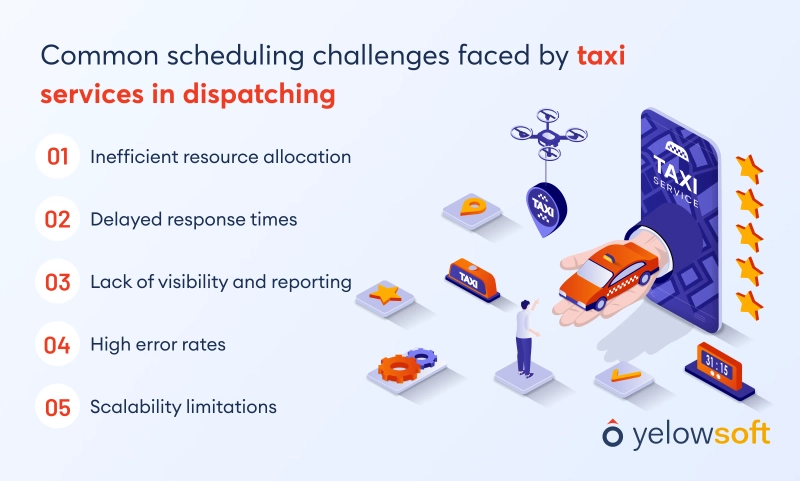Dispatching is crucial in all fleet management activities, regardless of the type of vehicles.
It evaluates the efficiency of resource utilization and the level of customer satisfaction.
Nevertheless, the process of creating a schedule is frequently plagued with obstacles that can interfere with operations.
Manual dispatch systems, despite being common and inexpensive in the beginning, have built-in restrictions.
They heavily depend on human involvement, causing delays, mistakes, and inefficiencies.
In contrast, dispatch systems utilize technology to simplify the process, providing quickness, precision, and flexibility.
This blog examines the main difference between manual vs. automated dispatch, with a focus on how automation addresses typical scheduling obstacles.
What is manual dispatch?
Manual dispatch refers to the process of allocating tasks, vehicles, or drivers through traditional means like phone calls, spreadsheets, or handwritten notes. A human dispatcher manages schedules, addresses customer requests, and resolves conflicts that may occur.
Although this method could be effective with small fleets, it becomes less efficient as operations expand. A manual scheduling system need to manage numerous calls, manually monitor driver locations, and make task assignments based on guesswork.
Key challenges of manual dispatch
-
Human error: Human mistakes such as assigning tasks incorrectly, conflicts in scheduling, or miscommunications can result in delays and unhappy customers.
-
Limited efficiency: Manual procedures are slow and unable to cope with high-pressure scenarios.
-
No data insights: Lack of data insights makes it hard to analyze performance or enhance processes without real-time fleet monitoring.
What is automated dispatch?
Automated dispatch uses technology to allocate assignments and oversee schedules with minimal human intervention. Algorithms and live data are used to improve automated route planning, assign resources, and track progress.
For instance, a system that is automated has the capability to match the nearest driver to a request for pickup by considering traffic, location, and vehicle capacity. These systems work alongside tools such as GPS tracking, customer apps, and analytics dashboards to produce a smooth dispatching process.
Key benefits of automated dispatch
-
Speed and accuracy: Tasks are assigned instantly based on real-time data.
-
Scalability: Automated systems handle growing workloads effortlessly.
-
Data-driven insights: Advanced analytics enable continuous improvement.
Also read: Automation vs. Manual Dispatch: Cost Savings and Efficiency Gains
Common scheduling challenges faced by taxi services in dispatching
Challenges vary based on how you operate an manage your taxi business. But there are a few challengers that are common among taxi dispatch businesses. So, let’s see what those challenges are.

1. Inefficient resource allocation
Poor resource allocation is a major issue in dispatching. Unable to efficiently assign rides to drivers can result in a lot of waste of time.
Let’s see an example to better understand, suppose a ride is assigned to a driver and the location is far away. It is obvious that the driver will need more time to reach the customer. This can lead to unnecessary delays and customer dissatisfaction.
Dispatchers using manual methods frequently make errors because they have insufficient data on current situations such as traffic and driver availability. Effective allocation of resources ensures that all assets, including both vehicles and drivers, are used efficiently to reduce expenses and improve the quality of service.
Manually dispatch issues:
Manual systems depend on the dispatcher's decision making, which might not always take into account factors such as traffic or vehicle availability in real-time. This frequently results in less than ideal placements.
Automated dispatching solution:
Automated cloud-based dispatch systems utilize data to pair tasks with the most appropriate resources. For example, they have the option to allocate the closest driver or a vehicle with certain specifications, such as payload capacity or number of passengers.

2. Delayed response times
Fast response times are essential in sectors such as taxi services, delivery, and logistics. Nevertheless, manual dispatchers may find it challenging to react quickly, especially during busy periods or urgent situations.
Delays in communicating with drivers or updating schedules happen when dispatchers depend on calls, spreadsheets, or guesswork. This not only causes frustration for customers but also impacts the efficiency of operations. Delayed reactions can result in missed timeframes, abandoned reservations, or client grievances, all of which damage the firm's image.
Efficient communication and technology are essential in tackling this challenge.
Manual dispatch issues
Human operators may find it challenging to handle numerous requests promptly, particularly when there is high demand. The problem is made worse by delays in communication between dispatchers and drivers.
Automated dispatch solution
Fleet scheduling automation systems promptly address requests by prioritizing them according to urgency and resource availability. This guarantees fast response times.
3. Lack of visibility and reporting
Effective dispatching relies on having a thorough understanding of current operations. Monitoring driver performance, task progress, and fleet efficiency is difficult without accurate real-time fleet monitoring and comprehensive reporting.
Manual dispatch systems usually do not have the necessary tools to offer this level of visibility. Dispatchers have limited information and must rely on updates from drivers or customers in order to know the status of tasks. Additionally, proper reporting is essential for analyzing past performance to identify areas that need improvement.
Visibility and reporting are crucial for decision-making. They allow companies to identify inefficiencies and enhance their operations.
Manual dispatch issues
Manual systems do not have immediate tracking capabilities, which hinders the ability to oversee operations or pinpoint inefficiencies. This also implies restricted reporting functionalities, obstructing data-focused decision-making.
Automated dispatch solution
Automated scheduling software offers live monitoring of vehicles and tasks, providing dispatchers with full visibility. In-depth analytics dashboards provide information on performance metrics such as delivery times, fuel consumption, and driver productivity.

4. High error rates
Mistakes by humans are bound to happen in manual dispatch systems, specifically when handling intricate schedules with many components in motion. Common errors involve giving several tasks to one driver, conflicts in schedules, or neglecting important details such as vehicle upkeep.
These mistakes result in disturbances in operations, unhappy customers, and financial setbacks. For example, scheduling two drivers at the same time can result in delays and frustration for both clients and staff.
Reducing mistakes with automation and checks is crucial for upholding a dependable and effective operation.
Manual dispatch issues
Mistakes made by humans are bound to happen in manual systems, especially when the workload becomes more complex. Common errors can involve scheduling drivers for overlapping shifts or assigning jobs to vehicles that are not currently in service.
Automated dispatch solution
Predefined rules and checks are utilized by automated scheduling software to reduce errors in the scheduling process. For instance, they avoid scheduling conflicts and guarantee tasks are only given to resources that are free to work.
Also read: Manual Dispatch vs. Automation: Which One Suits Your Taxi Business
5. Scalability limitations
As companies expand, their scheduling requirements become increasingly intricate. Regrettably, traditional dispatch systems face challenges in keeping pace with this expansion.
Managing bigger fleets, more drivers, and a growing number of tasks may necessitate the recruitment of extra personnel to handle the increased workload. This method not only raises expenses but also complicates the coordination of operations.
Scalability is crucial for companies looking to grow their activities while maintaining efficiency and service standards.
Manual dispatch issues
Expanding a manual dispatch system typically involves bringing on more employees, leading to higher expenses and increased complexity.
Automated dispatch solution
Automated systems are created to easily expand in size. Growing businesses can easily incorporate new vehicles or take on more tasks without needing extra resources.
Manual dispatch vs. automated dispatch: A direct comparison
Manual dispatch systems and automated dispatch systems have notable differences in their approach to scheduling and managing resources. Next is a straightforward assessment of their skills.
| Aspect | Manual dispatch | Automated dispatch |
|---|---|---|
| Efficiency | More time consumed. | Processes are instant and seamless. |
| Accuracy | High risk of human error. | Uses algorithms to minimize mistakes. |
| Scalability | Limited without adding more staff. | Effortlessly handles growing workloads. |
| Cost | Initially cheaper but costly as operations scale. | Higher initial investment but cost-efficient long-term. |
| Customer satisfaction | Affected by delays and inefficiencies. | Enhanced through faster response times and reliability. |
Automated dispatch systems are superior to manual methods, especially for businesses looking to expand and enhance service excellence.

Why businesses are transitioning to automated dispatch
Businesses in various sectors are moving towards automated dispatch systems to address the constraints of manual processes and achieve a competitive advantage.
- Improved efficiency and productivity
Automated scheduling software make scheduling more efficient by assigning tasks based on real-time data. This reduces wait times, guarantees efficient resource allocation, and allows dispatchers to concentrate on important duties rather than routine tasks.
- Enhanced customer satisfaction
Quicker response times, precise scheduling, and dependable service all enhance customer satisfaction. Automation helps to eliminate mistakes that could cause inconvenience to customers, such as delays in arrival or overlooked reservations.
- Cost savings
When compared to manual dispatch costs, the upfront cost of implementing automated scheduling software for dispatching may be expensive, they ultimately lower expenses in the long run by enhancing efficiency, decreasing mistakes, and eliminating the necessity for extra dispatch personnel. Businesses cut costs by automating tasks, leading to savings in fuel, time, and resources.
- Scalability and adaptability
Automated systems are created to expand along with the company. These systems easily accommodate new vehicles, expand service areas, and manage increased customer numbers.
- Data-driven insights
Automation allows for valuable data on fleet performance, driver efficiency, and customer behavior to be accessed. Businesses can utilize this information to make well-informed choices, enhance efficiency, and prepare for what lies ahead.

How to choose the right dispatch management solution for your business
Choosing the correct dispatch software requires recognizing the requirements of your business and assessing the choices that are accessible.
Key considerations:
-
Scalability: Make sure the system is able to handle the expansion of your business. It must have the capability to accommodate a growing number of vehicles, drivers, and tasks.
-
Features and functionality: Seek crucial elements like live tracking, automated scheduling, managing drivers, and analytics dashboards. The software must tackle your particular business requirements company.
-
Ease of use: The software must be easy to use. Complicated systems may cause dispatchers to resist and lower effectiveness.
-
Integration capabilities: The software needs to smoothly blend with various tools, like billing systems, customer applications, or GPS tracking. Integrating various components of the business guarantees a seamless workflow.
-
Cost vs. value: Although cost is important, concentrate on the lasting benefits that the software offers. Think about the potential future savings for your business in terms of time, effort, and money.
Conclusion
Traditional and familiar manual dispatch systems are no longer adequate for businesses looking to expand and meet current customer expectations. Automated dispatch software tackles the usual scheduling issues of inefficiency, delays, and errors. It provides a quicker and more precise solution.
Switching to automated systems can help you improve your operations. It can also allow you to increase customer satisfaction, and gain a competitive advantage. So, what are waiting for, it is time to make the shift to automated dispatching for fleets.





